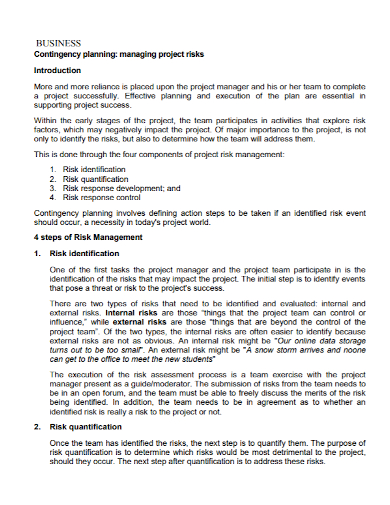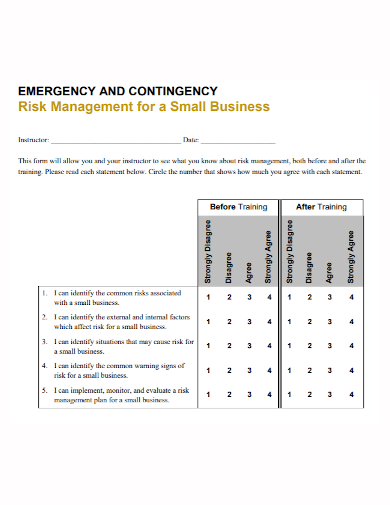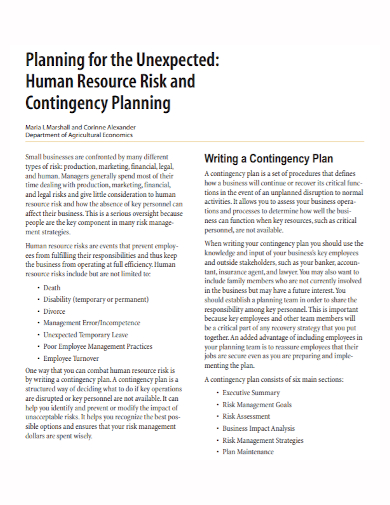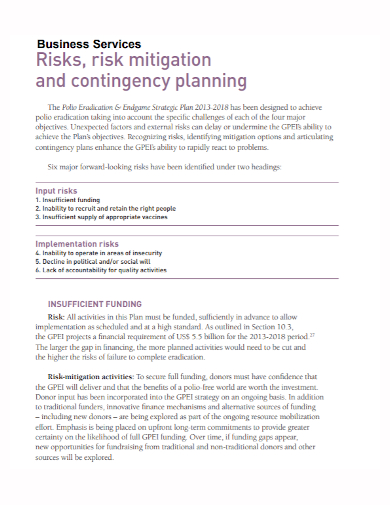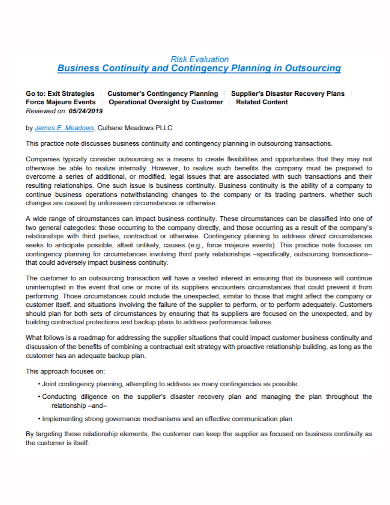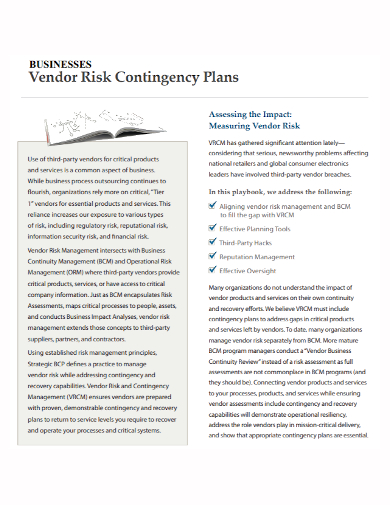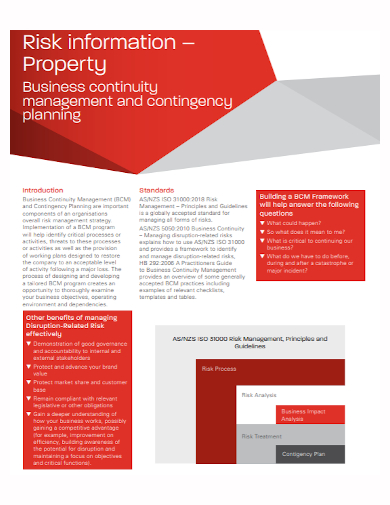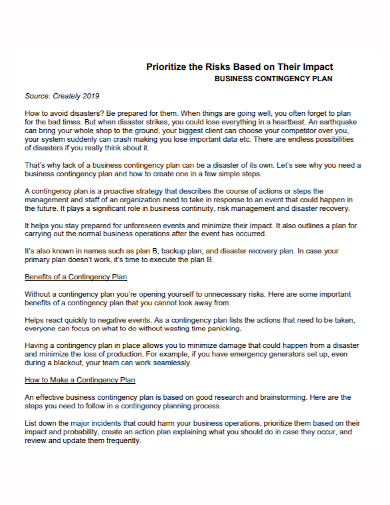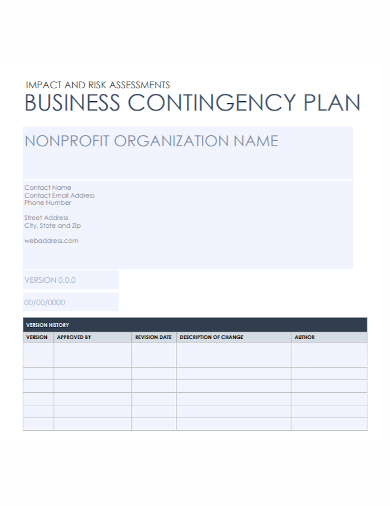Every business owner must be aware of the different contingencies that may occur to them that could dramatically affect their business; in most cases, it can affect them negatively. Contingencies are unexpected events that happen that affect the operations of a certain business for running smoothly. Some examples of contingencies are natural disasters, data breaches, scandals, and IT network failure, just to name a few. Being unaware and unprepared for negative situations put the business at great risk of losing their revenue or resources that are essential to keep their business open. Having a contingency plan can greatly prevent those negative impacts from happening and preserve your business and help you persevere through the negative event. If you want to know how to create a risk and contingency plan for your business, this article can help you make one.
10+ Business Risk and Contingency Plan Samples
1. Business Risk And Contingency Plan Template
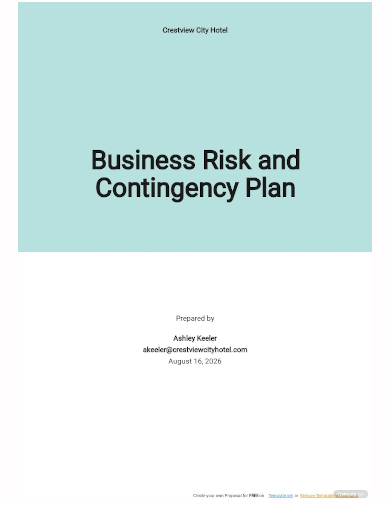
2. Business Project Risk and Contingency Plan
3. Small Business Risk and Contingency Plan
4. HR Business Risk and Contingency Plan
5. Business Risk Mitigation and Contingency Plan
6. Business Risk Management and Contingency Plan
7. Business Risk Evaluation and Contingency Plan
8. Business Vendor Risk and Contingency Plan
9. Business Risk Continuity and Contingency Plan
10. Business Risk Impact and Contingency Plan
11. Business Risk Assessment and Contingency Plan
What is a Business Risk and Contingency Plan?
Business risk and contingency plan is a document that lists down all the courses of action that your business should take if an unforeseen event or situation occurs. A good risk and contingency plan are well-researched on every potential threat that may likely happen in a business to equip it with efficient responses and activities when a crisis hits them.
How to Make a Business Contingency Plan
1. Determine All Major Risks
The first thing to do is to hold a meeting with your employees to discuss your contingency plan. Before you go about and ponder what risks can hit your business, know first the important details of your business. Know what nature does your business fall into, what products or services you offer, and what types of customers or clients you cater to. This will help you determine what risks may likely happen to your business. If you have a SWOT analysis document available in your business, you can refer to the Threats section where you identify the risks your business may face. Some common risks that may lead to unfortunate instances may happen in these areas:
- Staffing
- Technology
- Inventory
- Legalities
2. Prioritize the Risks
Once you’ve identified the risks, it’s time to prioritize them. Determine each risk’s probability to happen to you and how much it will impact your business. The risks that are more likely to happen and could cause greater damage to your business should be at the top of the priority list.
3. Create a Contingency Plan for Every Risk
Once you’re done prioritizing the risks, it’s time to create a plan for each risk. Make a detailed outline of what processes you will do to prepare for the risk to happen and the steps you will do to cope with the crisis and deescalate the damage to a minimum.
4. Share the Plan With Your Staff
Once you’re done creating the contingency plan, communicate with your employees and inform them about it. Explain it to them clearly so they will understand how to contingency plan will work out. Be available to address your employees’ questions, concerns, and suggestions. Make sure the contingency plan is accessible for every employee for them to use it.
FAQs
What are the benefits of a contingency plan?
There are a lot of benefits to having a contingency plan. Some of these benefits include:
- Help create a continuity plan for organizations after unexpected events happened
- It helps protect the organization’s resources
- It minimizes inconveniences for clients and customers
- It assigns specific responsibilities to key staff when unexpected events occur
What is the difference between a contingency plan and a business continuity plan?
A business continuity plan is a document where a business list down the processes they need to do to be able to carry out their normal operations after unexpected events occur that disrupted their business while a contingency plan defines the series of activities to do whenever an identified risk occurs to the business. A contingency plan predicts and prepares for the worst to come while the continuity reacts on how to cope after the damage has been done.
Make sure your contingency plan is flexible enough to be updated and revised from time to time. Your business and its operations evolve as time goes by and new risks and solutions are going to come up. Make sure your plan has space for those risks and solutions to be included. To help you get started making the contract, download our free sample templates above to use as your guide!
Related Posts
FREE 7+ Fashion Business Plan Samples in PDF
FREE 10+ Sprint Planning Samples In MS Word | Google Docs | PDF
FREE 10+ Wedding Planning Samples in MS Word | Apple Pages | Powerpoint | PDF
FREE 9+ Monthly Study Planner Samples in PSD | Illustrator | InDesign | PDF
FREE 9+ Sample Curriculum Planning Templates in PDF | MS Word
FREE 10+ Teacher Development Plan Samples in MS Word | Google Docs | Apple Pages | PDF
FREE 10+ Basketball Practice Plan Samples in PDF
FREE 12+ School Business Plan Samples in PDF | MS Word | Apple Pages | Google Docs
FREE 7+ Client Strategic Plan Samples in PDF | MS Word
FREE 11+ Trucking Business Plan Templates in PDF | MS Word | Google Docs | Pages
FREE 7+ Small Hotel Business Plan Samples PDF | MS Word | Apple Pages | Google Docs
FREE 14+ Bakery Business Plans in MS Word | PDF | Google Docs | Pages
FREE 4+ Yearly Lesson Plan Samples in PDF
FREE 50+ Strategic Planning Samples in Google Docs | Pages | PDF | MS Word
FREE 10+ Construction Project Plan Samples in MS Word | Google Docs | Apple Pages | PDF

